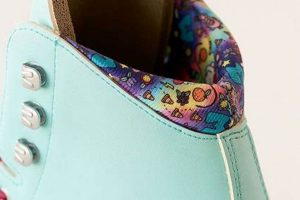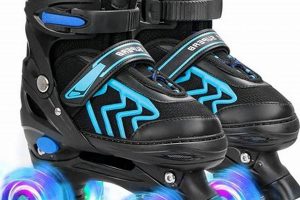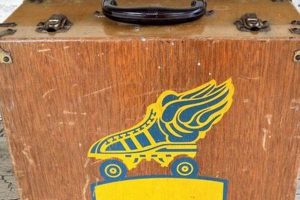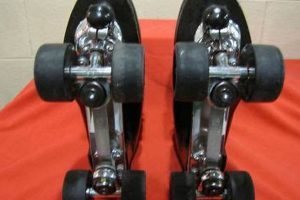Footwear, typically canvas-based and characterized by a distinctive rubber sole and toe cap, has been adapted for use in roller skating. This adaptation involves affixing a roller skate chassis, consisting of a plate, wheels, and trucks, to the sole of the shoe. This modification allows individuals to experience the activity of roller skating while utilizing a familiar and stylish shoe design.
The adaptation offers a unique blend of aesthetics and functionality. It provides a customized skating experience, allowing individuals to express personal style. Furthermore, this approach can offer a more affordable entry point into roller skating compared to purchasing dedicated skating boots. The practice also taps into a historical trend of adapting existing footwear for recreational activities.
The following discussion will explore the construction, performance considerations, and customization options associated with this particular type of adapted footwear, as well as address the potential benefits and drawbacks for various skating activities.
Modification and Usage Guidelines
The following guidelines address key considerations for adapting and utilizing canvas footwear for roller skating, promoting safety and optimal performance.
Tip 1: Chassis Selection: Ensure the roller skate chassis is appropriately sized and rated for the intended use and the individual’s weight. A mismatch can compromise stability and structural integrity.
Tip 2: Secure Mounting: Proper mounting of the chassis to the shoe is paramount. Employ professional installation services to ensure secure attachment using appropriate hardware and techniques. Inadequate mounting can lead to separation and potential injury.
Tip 3: Reinforcement Considerations: Assess the need for reinforcement of the shoe’s sole and upper. Depending on the intended skating style and frequency, adding layers of durable material can enhance longevity and support.
Tip 4: Wheel Selection: The selection of wheels should correspond to the skating surface and desired performance characteristics. Harder wheels are suitable for smooth surfaces, while softer wheels offer better grip on rougher terrain.
Tip 5: Regular Inspection: Conduct routine inspections of the entire assembly, including the chassis, mounting hardware, and footwear, for signs of wear, loosening, or damage. Promptly address any issues to maintain safety.
Tip 6: Ankle Support Awareness: Recognize that adapted footwear typically offers less ankle support than dedicated skating boots. Consider the implications for stability and risk of injury, especially for advanced skating maneuvers.
Tip 7: Intended Use Limitation: This type of adapted footwear is generally best suited for recreational skating and should not be used for high-impact activities or competitive skating without significant reinforcement and professional evaluation.
Adhering to these guidelines will help maximize safety, performance, and the lifespan of roller skate adaptations. Prioritizing proper installation and regular maintenance are essential.
The subsequent sections will explore advanced modifications and alternative footwear options for specialized skating disciplines.
1. Customization
The adaptability of canvas footwear to roller skating extends significantly into the realm of personalization. This customization is a key driver for individuals choosing this method over traditional roller skate boots, allowing for a high degree of self-expression and tailored functionality.
- Aesthetic Personalization
The inherent design of this modified footwear lends itself well to aesthetic personalization. Individuals can select from a wide array of colors, patterns, and embellishments to match personal style or reflect affiliations. This contrasts with standardized skate boot designs, providing an avenue for unique visual identities.
- Component Modification
Beyond aesthetics, the adaptation process allows for modification of individual components. Wheel type, truck tightness, and even the insole can be selected and adjusted to optimize performance for specific skating styles or terrain. This level of control is not always readily available in pre-built roller skates.
- Hardware Upgrades
Customization also extends to the hardware used in the mounting process. Skaters can opt for higher-grade mounting plates, bearings, and other components to improve durability and performance. This allows for a gradual upgrade path as skill level and skating demands increase.
- DIY Embellishments
The canvas material readily accepts various DIY embellishments, such as patches, studs, and paint. This fosters a sense of ownership and creativity, allowing skaters to transform their footwear into unique works of art. Such embellishments may express subcultural affiliation or personal narratives.
The potential for personalization significantly enhances the appeal of this modified footwear. It bridges the gap between functional sporting equipment and personal expression, fostering a deeper connection between the skater and their gear. This customized approach empowers individuals to create a skating experience that is uniquely their own.
2. Aesthetic
The visual appeal constitutes a significant factor in the adoption and appreciation of modified footwear for roller skating. This facet transcends mere superficiality, influencing user perception, brand identity, and the overall cultural significance of the activity.
- Material and Color Palette
The canvas material, inherent to this modified footwear, offers a diverse palette for aesthetic expression. Its receptive nature accommodates a spectrum of colors, patterns, and graphic designs. This variability allows for personalized adaptations, enabling individuals to align their skating equipment with personal preferences or subcultural affiliations. The availability of diverse materials, such as suede or leather alternatives, further expands aesthetic possibilities.
- Silhouette and Form Factor
The distinctive silhouette of the adapted footwear contributes to its visual recognition. Its inherently casual aesthetic differentiates it from traditional roller skate boots, often associated with more formal or athletic contexts. The low-profile design and minimalist form factor impart a sense of approachability and style, appealing to a broad demographic. The inherent shape allows skaters to express fashion statement.
- Custom Embellishments and Personalization
The canvas surface is amenable to various forms of customization, including the application of patches, studs, paint, and other embellishments. This facilitates individualized expression and fosters a sense of ownership. The ability to personalize the footwear allows skaters to showcase their creativity, affiliations, or personal narratives, transforming a functional item into a unique piece of wearable art.
- Historical and Cultural Connotations
The adapted footwear carries historical and cultural connotations that contribute to its aesthetic appeal. Its association with youth culture, alternative fashion, and skateboarding movements imbues it with a sense of rebellion and individuality. These historical connections resonate with certain demographics, enhancing its symbolic value and attractiveness.
In conclusion, the aesthetic dimensions of the adapted footwear extend beyond surface-level considerations. Its material properties, silhouette, customization options, and historical associations converge to create a compelling visual identity that resonates with skaters and shapes the perception of the activity itself.
3. Affordability
The economic accessibility of modified footwear for roller skating constitutes a primary factor driving its prevalence. This affordability stems from several interconnected aspects that collectively contribute to a lower barrier to entry compared to dedicated roller skating equipment.
- Lower Initial Investment
The cost of acquiring a pair of canvas shoes is generally lower than that of purchasing specialized roller skate boots. This price differential reduces the initial financial burden, making roller skating accessible to a broader range of individuals. The reuse of existing footwear further minimizes expenditure.
- Component-Based Investment
The ability to acquire roller skate components separately allows for a phased investment approach. Individuals can begin with a basic chassis and upgrade components incrementally as their skill level and budget allow. This modularity provides greater financial flexibility compared to purchasing complete, high-end skate setups upfront.
- Wider Availability and Price Competition
Canvas footwear is widely available from numerous retailers, fostering price competition and driving down costs. This contrasts with the more specialized market for roller skate boots, where fewer suppliers and less competition can result in higher prices. The accessibility and competitive pricing of canvas shoes contribute to their affordability in the context of roller skating.
- DIY Modification and Repair
The relative simplicity of modifying and repairing canvas footwear enables cost savings through do-it-yourself efforts. Individuals can perform basic maintenance, component replacements, and even reinforcement modifications without incurring professional fees. This self-sufficiency further reduces the overall cost of ownership.
These factors collectively contribute to the affordability of canvas footwear in roller skating applications. The lower initial investment, component-based approach, wider availability, and DIY modification potential make it a financially accessible option for individuals seeking to engage in the activity. However, it is crucial to balance cost considerations with safety and performance requirements to ensure a positive and sustainable skating experience.
4. Stability
The characteristic stability of roller skating configurations is significantly influenced by the choice of footwear. When adapting canvas shoes for this activity, stability becomes a paramount consideration due to the inherent differences between these shoes and purpose-built skating boots.
- Ankle Support Limitations
Canvas shoes typically offer minimal ankle support compared to traditional skate boots. This lack of support can compromise lateral stability, increasing the risk of ankle injuries, especially during abrupt movements or when navigating uneven surfaces. The skater must compensate for this deficiency through increased muscular effort and refined balance.
- Sole Rigidity and Chassis Mounting
The flexibility of the canvas shoe sole impacts the rigidity of the entire assembly. A less rigid sole can result in energy loss during propulsion and reduced responsiveness. Secure and precise mounting of the roller skate chassis to the sole is crucial for maximizing stability and minimizing unwanted movement between the shoe and the chassis.
- Center of Gravity and Balance
The relatively low profile of canvas shoes can offer a lower center of gravity compared to some skate boots, potentially enhancing balance for certain skaters. However, this advantage is contingent on proper chassis placement and individual skating technique. Improper chassis alignment can negatively impact the skater’s center of gravity and overall stability.
- Wheelbase and Truck Configuration
While not directly part of the footwear, the wheelbase and truck configuration of the attached roller skate chassis significantly influence stability. A wider wheelbase generally provides greater stability at higher speeds, while truck tightness affects maneuverability and responsiveness. Careful selection and adjustment of these components are essential for optimizing stability in conjunction with the chosen footwear.
The interaction of these factors underscores the critical relationship between footwear choice and stability in roller skating. While canvas shoes offer aesthetic and economic advantages, skaters must be cognizant of the potential limitations in stability and take appropriate measures to mitigate these risks. This may involve strengthening ankle muscles, refining skating technique, and carefully selecting and configuring the roller skate chassis.
5. Durability
The longevity and resistance to wear of canvas footwear when adapted for roller skating present significant considerations. The inherent design of these shoes was not originally intended for the stresses associated with roller skating, thus necessitating a careful evaluation of durability factors.
- Material Resistance to Abrasion
Canvas, the primary material, exhibits a certain level of abrasion resistance. However, repeated contact with abrasive surfaces, such as asphalt or concrete, during skating can lead to premature wear, fraying, and eventual material failure. Reinforcements, such as additional layers of canvas or the application of protective coatings, can mitigate this degradation.
- Sole Bond Integrity
The bond between the shoe’s sole and the canvas upper is a critical point of failure. The forces exerted during skating can stress this bond, potentially leading to separation. The adhesive used in the original shoe construction may not be adequate for the demands of roller skating, thus requiring supplemental reinforcement with stronger adhesives or mechanical fasteners.
- Chassis Mounting Stress Points
The points at which the roller skate chassis is attached to the shoe are subject to concentrated stress. Repeated impacts and torsional forces can weaken the surrounding material, leading to tearing or detachment of the chassis. Reinforcing these areas with metal plates or durable fabrics is essential for maintaining structural integrity.
- Environmental Degradation
Exposure to environmental factors, such as moisture, sunlight, and temperature fluctuations, can accelerate the degradation of canvas footwear. Moisture can weaken the fibers, while sunlight can cause fading and embrittlement. Protective measures, such as waterproofing and UV protectants, can extend the lifespan of the adapted footwear.
The long-term viability of using modified canvas footwear for roller skating depends heavily on addressing these durability concerns. While the aesthetic and economic advantages may be appealing, skaters must implement appropriate reinforcement and maintenance strategies to ensure the equipment can withstand the rigors of regular use. Failure to do so can result in premature failure and potential safety hazards.
6. Performance
The attainable level of performance when utilizing adapted canvas footwear for roller skating is contingent on several interconnected factors. These factors include the properties of the footwear itself, the selection and configuration of the roller skate chassis, and the skill and technique of the skater. The inherent limitations of canvas shoes, compared to dedicated skating boots, introduce specific challenges to achieving optimal performance. For instance, the lack of rigid ankle support in canvas footwear can impede precise control and responsiveness, particularly during advanced maneuvers such as spins or jumps. Conversely, the lighter weight of the footwear may offer an advantage in terms of agility and maneuverability for certain skating styles.
Proper component selection and meticulous assembly play a crucial role in mitigating performance limitations. The roller skate chassis should be appropriately sized and securely mounted to the shoe to ensure stability and efficient power transfer. Wheel selection should correspond to the intended skating surface and desired performance characteristics. For example, harder wheels provide greater speed on smooth surfaces, while softer wheels offer enhanced grip on rougher terrain. Furthermore, reinforcement of the shoe’s sole and upper can improve durability and responsiveness, enhancing overall performance. Actual skaters competing in roller derby will modify their setups based on the derby track flooring. An indoor wood surface or sport court will impact wheel choice.
Ultimately, the performance achievable with adapted canvas footwear is a function of carefully balancing the advantages and disadvantages. While dedicated skating boots typically offer superior performance potential, skilled skaters can achieve impressive results with modified footwear by optimizing their equipment and technique. The practical significance lies in understanding these limitations and implementing appropriate measures to maximize performance while prioritizing safety.
Frequently Asked Questions About Roller Skate Converse
The following section addresses common inquiries and misconceptions concerning the adaptation of canvas footwear, specifically recognizable brands such as Converse, for use in roller skating.
Question 1: Is adapting canvas footwear for roller skating a safe practice?
The safety of this practice depends heavily on proper execution and adherence to safety guidelines. Secure mounting of the chassis, reinforcement of stress points, and an awareness of limited ankle support are crucial. This configuration is generally less safe than dedicated roller skate boots, particularly for high-impact activities.
Question 2: What are the primary advantages of using roller skate Converse over traditional roller skates?
The primary advantages include aesthetic customization options, potential cost savings, and the ability to utilize familiar footwear. This approach allows individuals to express personal style and potentially enter roller skating at a lower initial cost.
Question 3: How does the durability of roller skate Converse compare to that of standard roller skates?
Roller skate Converse generally exhibit lower durability than standard roller skates. The canvas material and sole construction are not designed for the stresses of roller skating, leading to accelerated wear and potential failure. Reinforcement measures are often necessary to improve longevity.
Question 4: What types of roller skating activities are best suited for roller skate Converse?
This type of adapted footwear is generally best suited for recreational skating on smooth surfaces. It is less suitable for aggressive skating, high-impact maneuvers, or competitive roller skating, where the limitations in ankle support and durability can pose safety risks.
Question 5: What is the recommended procedure for mounting a roller skate chassis to canvas footwear?
Professional installation is strongly recommended. The process involves precise alignment, secure attachment using appropriate hardware, and potential reinforcement of the sole. Improper mounting can compromise stability and lead to equipment failure.
Question 6: Are there specific brands or models of canvas footwear that are better suited for adaptation as roller skates?
Footwear with a durable sole construction and a relatively flat profile is generally preferred. Models with reinforced toe caps and sturdy canvas material may offer improved durability. However, the suitability of a particular model depends on individual preferences and the intended skating application.
In summary, adapting canvas footwear for roller skating offers a unique blend of style and functionality, but requires careful consideration of safety, durability, and performance limitations. Proper execution and adherence to safety guidelines are essential for a positive and safe skating experience.
The next section will explore alternative footwear options for roller skating and provide recommendations for selecting appropriate equipment based on individual needs and preferences.
Conclusion
The preceding exploration of roller skate Converse has highlighted the multifaceted nature of this adapted footwear. Its appeal stems from a confluence of aesthetic, economic, and customizable attributes. However, inherent limitations in stability and durability necessitate careful consideration and proactive mitigation strategies. The adaptation is not without risks, requiring a balanced assessment of potential benefits against inherent compromises in performance and safety relative to dedicated roller skating equipment.
The decision to adopt this style of adapted footwear demands a responsible approach. Individuals must prioritize safety through meticulous execution, appropriate reinforcement, and a clear understanding of activity limitations. Further research and adherence to established safety guidelines are encouraged for all practitioners, thereby fostering a culture of informed and responsible participation in roller skating activities.






![Best Roller Derby Skates UK: [Your City] & Beyond! How to Skateboard: A Beginner's Guide to Your First Board & Tricks Best Roller Derby Skates UK: [Your City] & Beyond! | How to Skateboard: A Beginner's Guide to Your First Board & Tricks](https://cruzskateshop.com/wp-content/uploads/2025/11/th-458-300x200.jpg)
